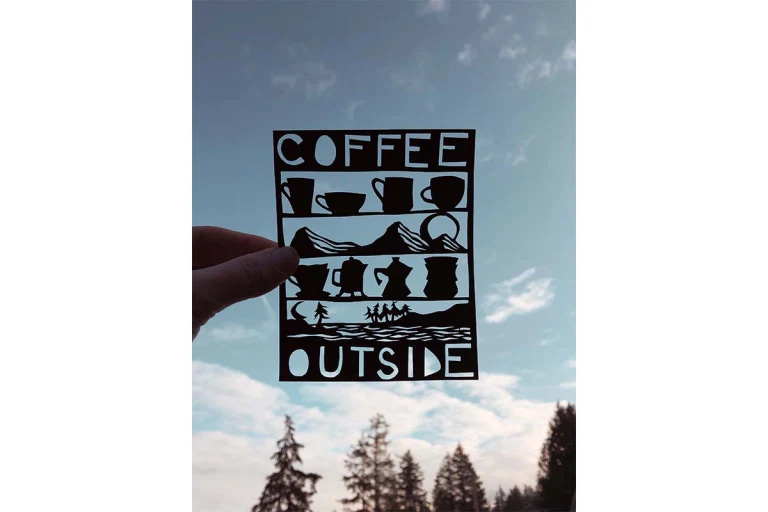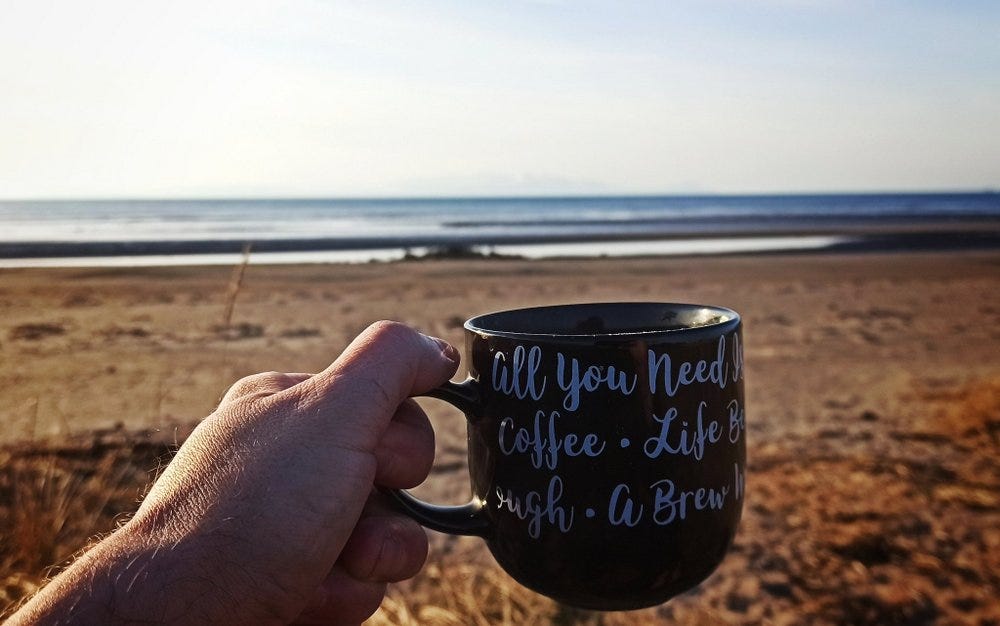Five Weird Ways To Enjoy Witching Week
It's almost that strange, peculiar, WTF non-time once again.
Hi!
I’m recovering slowly but surely from a tussle with Covid-19, and since my voice currently sounds like a supermarket trolley full of scrap metal being pushed down a cobbled street, I’m still not able to record the audio essay I originally planned for you at the weekend.
So, as with the newsletter from a few days ago, I’m re-running a piece from this time last year - when there were around half as many of you reading EiA as there are now. (It’s been madness, all of it. Don’t have the words.)
It’s about what’s usually seen here in Britain as the anticlimactic end of the year, all boredom and twiddled thumbs, a time to squander and fritter away - and so a time well worth reclaiming, because instead of accepting it as an emotional “no-space” where nobody truly lives these days, maybe we could rediscover its many identities (as
is doing here) and get a lot more comfortable with it…If you’re looking for something a bit more hard-sciencey, or you live in the Southern Hemisphere where it’s high summer right now, try this piece on the remarkably unpleasant challenges of living underwater, which includes the details of this true story:
“In 1965, Colin Irwin, a 19 year-old from Bournemouth (England), decided he wanted to live in a steel tank weighed down with sections of railway line at the bottom of the sea for a week.”
Okay. Back in a few days!
- M
******
Hello! This is Everything Is Amazing, a science-based newsletter about getting curious, learning new stuff and doing gently bizarre things to bring a little awe and wonder into your day.
In recent editions, we’ve leaned heavily into the first two of these: the farcical joy of inventing your own colours, the weirdness of cloud formations that really hammer home that we live at the bottom of an ocean of air, the strange things that the skies of Mars might do to the minds of future explorers, and a bit on the science of kindness (which really is a thing, I promise).
But enough reading. How about some applied curiosity, awe and wonder?
There are two excellent reasons to ignore the rest of this newsletter. (Three, if you’re already finding me a bore.)
The first is you’re scurryfunging around in preparation for the holidays:

And the second is you’re just trying to keep warm. The Arctic bomb cyclone that’s powering into Canada and the United States right now is being described as a ‘once-in-a-generation event’ - and I’m seeing reports from friends across the Atlantic of temperatures lower than I can possibly imagine.
(For example, Antonia of On The Commons posted on Substack Chat that her local ski mountain in Montana was seeing -60 F / -51 C windchill. That’s only 14 degrees Celsius above the average surface temperature of Mars! Ye gawds.)
So, please keep your extremities & Special Areas deliciously warm, and if you want to curl up with something awe-inspiring and sciencey, read this fantastic piece by Will Dowd that’s all about moon dust (“as jagged as coral and…as sticky as the fine hairs on a gecko’s feet”).
But for the sake of applied curiosity, let’s pretend the next four or five days have now gone by in a whirl of warm hugs, bad jokes, a bit too much rich food, an unexpected dash to the shops for some kind of indigestion relief medicine, and all the fun of utterly terrible weather outside when you’re deliciously warm inside, pressing your face close to the window until you feel the cold puffing against your cheeks.
I mean, that’s pretty fun. A few days of that is time well spent.
But then you’re into the Witching Week: the period between Christmas and New Year that nobody quite knows what to do with.
It’s not even called “the Witching Week,” not really - that’s just one of a number of names people on Twitter cooked up for it a few years back (along with “Twixtmas,” “Crimbo Limbo” or, rather graphically, “The Festive Perineum”).
(UPDATE: thanks to
‘s newsletter I found this piece by Helena Fitzgerald at The Atlantic calling it “Dead Week”. Add that to the list.)In Wintering, Katherine May describes it as:
“…that strange period between Christmas and New Year, when time seems to muddle, and we keep finding ourselves asking, “What day is it? What date?” I always mean to work on these days, or at least to write, but this year, like every other year, I find myself unable to gather up the necessary intent. I used to think these are wasted days, but I now realise that’s the point….I’m just letting my attention shift for a while, away from the direct ambitions of the rest of the year. It’s like revving my engines.”
So if that feels like the right way to spend the week, you should absolutely do that.
But since this is such a weird time - a liminal non-space kind of a thing where nothing and nobody quite exists, a bit like an airport or a shopping mall - how about doing something novel, unnecessary and more than a little daft-feeling with it?
Applied curiosity is all about trying to discover what you don’t yet know you don’t know, which for obvious reasons is really freaking hard. So one of the best ways to find it is to trip over it while walking backwards (mainly metaphorically, unless you’re really lucky/clumsy). You have to do something pointless, in the hope that the point will, like a magic trick, reveal itself to you enroute, seemingly out of nowhere.
So, with that in mind, and borrowing from a number of challenges I was running in the first season of this newsletter, here are some pointless things you can do with the post-Xmas WTF.
1. Walk Back
This is stolen from adventurer Al Humphreys, and it’s really simple: you take some form of local public transport, but you only buy a one-way ticket, because you’re hoofing it back home.
The joy of this isn’t really the walking (although a walk of any length is certainly a fine thing) - it’s really the perspective-shift it gives you. It turns that distanced, TV-like blur of terrain outside the bus or train or car window of your regular commute into an Actual Place You’re Actually In. You can hear it. You can smell it. It’s an unexpected party for the senses.
(Here in Ayrshire I’m only a few minutes from the local train station, so dozens of times this year I booked myself a one-way train ride down the coast, a little further each time, to get myself used to walking long distances again. Along the way I’ve discovered tiny secret woods, a strange tunnel running into the ground towards one of the Scotland’s major airports, a bridge that goes (from what I can tell) absolutely nowhere, and other stuff besides. It’s become what I do when my brain is getting dulled and fogged up, I’ve really started to look forward to it - and, I suspect, it’s the start of a rest-of-lifetime habit.)
Go walk home. You might discover something amazing along the way.
2) Move A Daily Ritual Outside
Again, stolen from Al (sorry, Al!), but also from writer and artist
(whom I interviewed a while back). Last year they teamed up to encourage everyone to have a coffee outdoors:My rule for myself: I can only drink my first coffee of the day somewhere without four walls and a roof - or maybe leaning slightly out of one.
My reason for doing this is simple: I’m still fairly rubbish at mornings. I need that coffee in me ASAP - but I also want to start my day, however briefly, with a faceful of sky and a few lungfuls of insanely cold fresh, clean air.
Since the beach is only a few minutes away, this habit looked like this:
So what part of your daily ritual could you shift somewhere under the open sky, to ensure you’re getting a healthy bit of The Unpredictable Outside into your day, without fail?
If you accept this challenge (and you commit to doing it), you’re about to find out.
3) “Lagom” Your Possessions
Say what now?
It's a Swedish word. My friend Lola wrote a book about it. Anna Brones wrote a different book about it. They’re both great.
But if you want it in a nutshell, lagom more or less means "moderation" - or "just enough" or "not too much, not too little" or all the other Goldilocks-esque synonyms we use to denote enoughness.
Enoughness is coming back into fashion in a big way. Toomuchness seems to be at the heart of a lot of modern ailments, like the environment-ruining pressure that encourages us to always strive to acquire the next new expensive shiny thing - which usually leaves us just as dissatisfied as before, except materially overwhelmed and financially broke as well.
All those worlds of pain won't be fixed in one tiny challenge like this, so let's zoom in on just one part of it.
Your house is filled with things you haven't used or enjoyed in ages - and in most cases, that's really bad for your peace of mind. Unused possessions tend to have a tiny amount of guilt attached to them. A part of your emotional bandwidth. A little voice yelling, "I’m here to remind you of all the things you never got round to. Or, putting it differently, the ways you suck! LOL!”
(No wonder you hide them in the back of cupboards all the time.)
You can go full Marie Kondo on this and get really silly - but this isn’t really about going hardcore minimalist until your home feels empty and lacks a visible human history. This is just about knowing what you have - so you can decide if you actually want it or not.
Time to kill lingering material regrets and move on. Here's how.
First Steps
Audit your possessions. Have fun going through everything - clothes, books, sports equipment, anything you've been hanging onto because who-quite-knows-why. Rediscover it anew. Have all those “OMG I FORGOT I HAD THIS!” moments.
Find anything you haven't used or enjoyed in 2 years, and put it in a pile, metaphorical or otherwise. Antiques, family heirlooms and items intended for someone else are out, obviously, but anything else is up for grabs. Pile it up.
Are you going to use it this month? Really? Last chance. If you really want to start playing Twister again, or get using those kettle bells you had to put in the garden shed, or finish knitting those MC Hammer pants, or learn Demotic Klingon, why don't you just start? It’d only take a minute, and you could only do a minute, every day. Too much hassle to consider? If so...
Why not get rid of it? Sell it. Give it to a charity shop. Or pass it along to a neighbour. Or ask someone else you know if they’d like it. Or offer to gift it to a suddenly-freaked-out-looking stranger. Just get rid. Draw the line and make sure this stuff is finally on the other side of it. Then see how you feel. Better? Then do it again - until everything that's left is stuff you actually, really want. Hey presto! Your home is suddenly a hell of a lot more fun to be in, just in time for the New Year.
4. Teach The Basics To Someone Who Doesn’t Know Them
Have you ever heard the truism that the best way to learn something is to teach it to others?
“Students enlisted to tutor others, these researchers have found, work harder to understand the material, recall it more accurately and apply it more effectively. In what scientists have dubbed “the protégé effect,” student teachers score higher on tests than pupils who are learning only for their own sake.”
Here’s a challenge that will help two people become more curious (this challenge is very good value for money).
So, there’s you, and there’s another person - and you’re going to agree to do the following: taking it in turns, you’re going to give each other a short lesson on something you’re interested in and knowledgeable about. Let’s say, ten minutes each.
What could you give someone an enthusiastic ten-minute lesson about? Something you really love. Something you get nerdy about. Something you wish more people knew about, because it’s just so damn interesting.
Boil it down. Give them your best ten minutes on the subject. Go all-in.
And then they do it back to you, on a subject they care about.
The value of doing this is twofold. Firstly, you’re creating one end of an information gap - “a little foreknowledge, to break the crust of it,” as I said here. We’re generally not curious about things we know nothing about, but if somebody else can successfully teach us just a little bit about those things, our own curiosity can kick in and take us the rest of the way. And secondly, the teacher is forced to compose and boil down their own thoughts into a form that’s clear enough to be communicated to someone else. It’s a real win-win.
Many, many bonus points awarded if you do this with a total stranger and they actually enjoy it. (Let’s face it, this can go super-wrong.)
So what are you going to teach someone else this week?
(Drop this newsletter a comment if you do this one. I’d love to know what you did.)
5) Find Your Nearest Ruin
When I was a teen living on the east coast of England, there was a ruined building just up the road, filled with the ghosts of dead people.
No, really. I was convinced of this. Behind a once-huge crumbling farmhouse now overgrown with nettles and brambles that savaged the undercarriage of anyone idiotic enough go exploring them wearing badminton shorts (hi), there was a wartime pillbox, mirroring the one at the other side of town near a deserted medieval village. This one was concreted shut, but you could shine a torch through the embrasures to see it was filled with water.
Then the not-so-good smell would hit you at the exact same moment you saw…well, things, bobbing around. Bodies, obviously! Let’s forget logic, or the basic rules of biological decomposition. They were bodies.
Most ruins aren’t so dramatic - but they certainly are poignant, evocative and filled with reminders about how forgiving, resilient and filled with non-human purpose the natural world is. (This remarkable book will make abandoned places irresistible to you for years to come. You don’t have to read it to do this challenge, but it’ll certainly help.)
Here, then, is your task:
1) Find your nearest ruin - a building formerly occupied by human beings, now by birds and other adventurous wildlife.
2) Then find that ruin’s name.
I mean, it wasn’t always called “The Ruin”. For example, that wreck of a place around the corner from my East Yorkshire home was called Trinity House (which is why, when it was razed a few years later and turned into a housing development, the street that replaced it is called Trinity Road, and the surrounding area the Trinity Fields residential estate). Knowing that name makes me want to learn more. Why “Trinity”? Who lived there? Who owned it when it was in ruins? And so on.
Find it. Learn its name. And then see if you want to dig deeper. That’s your job before New Year.
Thanks for reading!
- Mike
Images: Paul Green; Rodion Kutsaiev; Andy Holmes; Katherine May; Anna Brones; Mike Sowden.








I'm not someone who follows rules, but if I were to write down my intentions and actions, this guide would be pretty damn close. Also, I love the coffee rule. Have you tried waiting an hour and a half before drinking coffee? There's a good video from Huberman about why to do it: https://www.youtube.com/watch?v=n3b9QKo_VpM
I love this idea of making use of the liminal time we’re in this way! If it counts, I’m teaching my kids how to make homemade pasta today. In return, they’re going to “teach mom how to do art.” I wish them luck with that last part as I’m truly awful.